
On September 30th, 2013, moments before the last handful of federal inmates were transferred to different facilities, the Kingston Penitentiary held the distinction of being the oldest prison on Earth still in continuous operation. Sitting ominously on the lapping shores of Lake Ontario in Kingston, the notorious penitentiary housed federal inmates serving anywhere from two years to life sentences, and has been home to some of Canada's most infamous criminals.
The Provincial Penitentiary of the Province of Upper Canada was constructed in 1835, before the birth of the country of Canada. Shortly after confederation it became known as the Kingston Penitentiary, and in time became referred to by inmates, guards and locals simply as KP. Constructed with local limestone using convict labour, the imposing structure became a model for other institutions the world over for over a century to come and was even admired by the likes of Charles Dickens, who toured the facility in 1842.
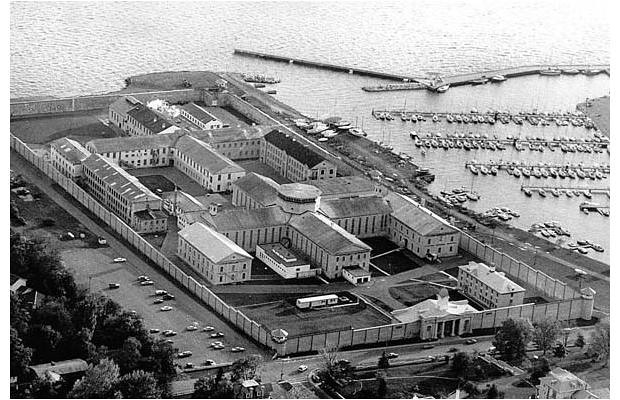
Historical aerial image (Image found online)
Women, children, vagrants, and lunatics were all admitted to KP, until the time the Rockwood Lunatic Asylum (1870) and Prison for Women (1934) were constructed nearby, also using KP inmate labour and local limestone. The very first inmate to be admitted to the prison was Matthew Tevender in 1835. Boys and girls as young as 8 years old, such as Antoine Beauche were sentenced to serve time at KP for crimes as minor as pick-pocketing.

Historical aerial image (Image found online)
Women, children, vagrants, and lunatics were all admitted to KP, until the time the Rockwood Lunatic Asylum (1870) and Prison for Women (1934) were constructed nearby, also using KP inmate labour and local limestone. The very first inmate to be admitted to the prison was Matthew Tevender in 1835. Boys and girls as young as 8 years old, such as Antoine Beauche were sentenced to serve time at KP for crimes as minor as pick-pocketing.
The architecture and philosophical underpinnings of KP were carefully designed to influence its inhabitants behaviour and create compelling incentive for reform. An enormous cross shaped 5 storey cell block was linked by a domed rotunda and a similarly designed building housed the workshops. For inmates at KP, the whole world existed within this 10 acre walled enclosure. A large bell was placed in the rotunda area of the Main Dome and its shrill ring directed inmate movements and became a hated symbol of control. A then revolutionary penal method known as the Auburn system was used in which inmates worked during the day and were kept in solitary confinement by night. Cells that measured 2x8 feet, with small barred openings in thick wooden doors for ventilation and supervision and were separated by thick concrete to prevent communication. Prisoners sentenced to KP could not even discuss their fate – a strict rule of silence existed until 1935, forbidding all forms of verbal and non verbal communication between prisoners, which it was believed could lead to “further moral contamination.”
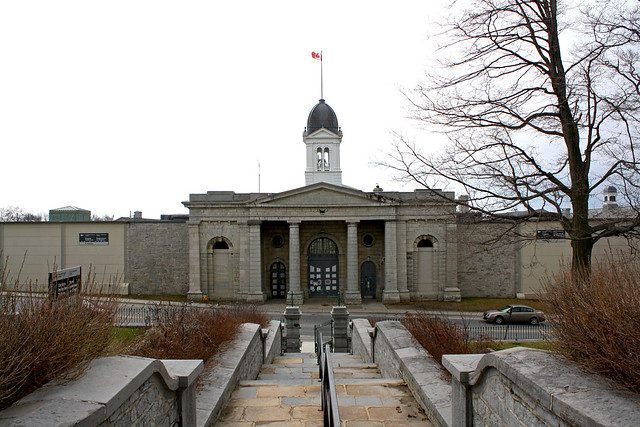
The first warden Henry Smith was a notorious sadist and dished out cruel and unusual forms of corporal punishment: lashings (known as “the cats”), meals of bread and water, confinement to a dark cell, the water bath punishment, and perhaps most dreaded, “the box,” an upright coffin in which prisoners were forced to stand for minutes or hours at a time. Reports indicate some prisoners were lashed to the point of insanity and after a 14 year reign, Warden Smith was fired for his excessive use of punishment. Corporal punishment at KP continued until 1969.
The Warden's Residence was constructed in 1873, directly across from the front gates, and and is now the home of Canada's Penetentiary Museum.
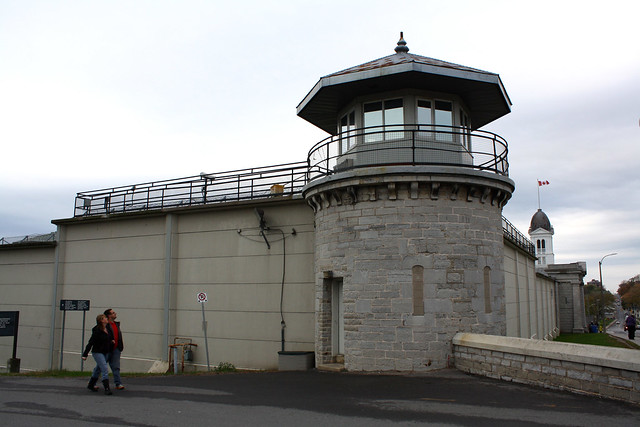
Prisoners worked long hours, from 5:15am-6:30pm every day but Sunday cutting limestone, making furniture, working in the canvas shop or as utility workers within the prison. They participated in recreational activities such as baseball, movies and at one point even ran a local radio show.
Riots at the prison were well publicized. The first in 1932 developed into a six day disturbance and was only resolved after the Warden promised to take prisoner demands to Ottawa.
In 1954, a guard was attacked during a morning baseball game and inmates set fires to buildings in the yard. Up to 900 inmates were involved and a breakout was attempted, but was subdued when the Army was called in to quell the uprising. Inmates caused over $2 million in damages in just a few short hours.
Perhaps the most infamous though, the riot of 1971. It lasted over four days and involved guard hostage taking, assaults, and physical destruction. The despised bell in the rotunda was smashed by an inmate that must have felt on top of the world in that moment. Again the army were called in to terminate the situation. When the dust settled, two inmates were dead and the public wanted answers. Television reporters were admitted to record the extensive damage to the prison. The South Wing was so badly damaged, that it never re-opened as a cell block. Public outcry led to demands for an inquiry into the riot and a discussion related to the treatment of inmates. The inquiry determined the cause of the riot to be due to decreased recreation time, lack of work, overcrowding, and aged physical facilities.

Escape attempts were equally well publicized and often romanticized by the media. Norman “Red” Ryan, a burglar, used a makeshift ladder to climb over the wall after stabbing a guard with a pitchfork, while other prisoners lit a fire to distract guards one morning in 1923. He robbed a bank and fled to the United States where he remained uncaught for over a year. Back in prison he began life anew as a “model prisoner” and convinced the then Prime Minister to release him (called “ticket of leave,” a predicate to parole). But he was a criminal at heart and resumed robbing banks and was ultimately killed in a gun fight during a liquor store robbery in 1936.
Tyrone “Ty” Conn, a bank robber, also made it over the wall using a ladder. Ty left a dummy in his bed and hid in the canvas repair shop under Canada Post mail bags until night fell. He sprinkled cayenne pepper behind him to throw dogs off his scent and climbed over the 10 meter wall. No one had escaped the prison for over four decades but Ty had a history of escaping custody and made it all the way to his mother's home in Belleville. Two weeks later he was cornered by police in a basement of a Toronto home and died from a self inflicted gunshot.
KP housed some of Canada's worst and most infamous criminals, from James Donnelly in the 1800s, to serial killer Clifford Olsen aka the Beast of BC, Col. Russell Williams, and school girl killer Paul Barnardo. These reviled convicts called the Dissociation Unit home, which was referred to by staff as “the toilet of the prison."
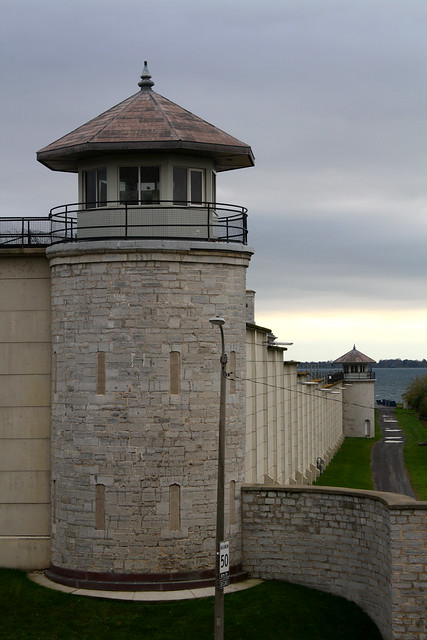
In 1990 the Kingston Penitentiary was designated a national historic site of Canada.

Escape attempts were equally well publicized and often romanticized by the media. Norman “Red” Ryan, a burglar, used a makeshift ladder to climb over the wall after stabbing a guard with a pitchfork, while other prisoners lit a fire to distract guards one morning in 1923. He robbed a bank and fled to the United States where he remained uncaught for over a year. Back in prison he began life anew as a “model prisoner” and convinced the then Prime Minister to release him (called “ticket of leave,” a predicate to parole). But he was a criminal at heart and resumed robbing banks and was ultimately killed in a gun fight during a liquor store robbery in 1936.
Tyrone “Ty” Conn, a bank robber, also made it over the wall using a ladder. Ty left a dummy in his bed and hid in the canvas repair shop under Canada Post mail bags until night fell. He sprinkled cayenne pepper behind him to throw dogs off his scent and climbed over the 10 meter wall. No one had escaped the prison for over four decades but Ty had a history of escaping custody and made it all the way to his mother's home in Belleville. Two weeks later he was cornered by police in a basement of a Toronto home and died from a self inflicted gunshot.
KP housed some of Canada's worst and most infamous criminals, from James Donnelly in the 1800s, to serial killer Clifford Olsen aka the Beast of BC, Col. Russell Williams, and school girl killer Paul Barnardo. These reviled convicts called the Dissociation Unit home, which was referred to by staff as “the toilet of the prison."

In 1990 the Kingston Penitentiary was designated a national historic site of Canada.
On April 19, 2012, 177 years after it first opened, the Federal Government announced plans to close KP and transfer the approximately 900 inmates to surrounding facilities. Public safety minister Vic Toews stated: “Institutions built in the 19th century are not appropriate for managing a 21st century inmate population.”
The media is currently a blaze with stories of the buildings future with reports of hopeful plans of conversion and potential ideas for reuse, including a world class sailing facility or a tourist attraction a la Alcatraz North. No matter what its future, the Kingston Penitentiary and its storied history has left its mark on the Canadian psyche.
I have always wanted to see the inside of Kingston Penitentiary, and when the United Way announced that they would be giving tours for charity, I leapt at the opportunity to get inside.
On October 16th, a mere 16 days after the last batch of inmates were transferred out, we took a tour of KP. Guards were still wandering the halls and chatting amongst themselves. The tour route was rather basic, but covered much of the grounds and a fair amount of building interiors, although always remaining on ground level. I managed to stray from the tour a few times and evade the eyes of guards and volunteers to access a few off limits areas, but it sure would be fun to get in there alone and poke around. There is so much more to see. Hopefully one day the opportunity arises, but for now, please come with me and look around the Kingston Penitentiary.
Our point of entry presents itself in the form of the main gate, and we follow in the footsteps of generations of guards and visitors over the past 177 years and pass through into the lobby. We stand under the tall white angled pillars between grey limestone walls and I poke my head against the glass and spark a conversation with the guard in the control booth. He grants me permission to shoot inside the booth, and is even accommodating enough to turn on the lights. We take a moment to soak in the lobby before venturing forth into the V&C Building (Visitation & Correspondence). Guards watched over the open visitation room from the control room, where glass topped tables were designed to allow maximum supervision and microphones were implanted in the silver caps atop the tables to monitor interactions.
On October 16th, a mere 16 days after the last batch of inmates were transferred out, we took a tour of KP. Guards were still wandering the halls and chatting amongst themselves. The tour route was rather basic, but covered much of the grounds and a fair amount of building interiors, although always remaining on ground level. I managed to stray from the tour a few times and evade the eyes of guards and volunteers to access a few off limits areas, but it sure would be fun to get in there alone and poke around. There is so much more to see. Hopefully one day the opportunity arises, but for now, please come with me and look around the Kingston Penitentiary.
Our point of entry presents itself in the form of the main gate, and we follow in the footsteps of generations of guards and visitors over the past 177 years and pass through into the lobby. We stand under the tall white angled pillars between grey limestone walls and I poke my head against the glass and spark a conversation with the guard in the control booth. He grants me permission to shoot inside the booth, and is even accommodating enough to turn on the lights. We take a moment to soak in the lobby before venturing forth into the V&C Building (Visitation & Correspondence). Guards watched over the open visitation room from the control room, where glass topped tables were designed to allow maximum supervision and microphones were implanted in the silver caps atop the tables to monitor interactions.
As we step outside the V&C building and the inside of the walled city of KP reveals itself, I cannot contain my excitement and I instantly stray from the tour. I turn left and pass by the family visitation units and shoot up at the birdhouse under the Northeast guard tower before rejoining the tour.
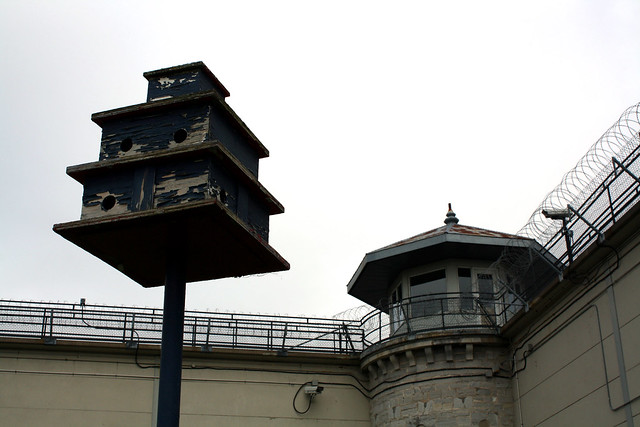

Then I scurry past the group and out the other side to take a look back at the inside of the main gate.
I turn around and spot another birdhouse. Behind it, the Main Dome stands ominously under a brooding grey sky.
The cell blocks extend from the Main Dome.
H Block. (The Dissociation Unit)
G Block.
F Block.
I check doors every chance I can, turning random doorknobs, hoping for that extra glimpse. A long shot I know, but in F block, one of them opens. I'm running up the metal staircase checking the doors to the higher levels of ranges but all the doors are locked. That is until the top floor where a door opens into a dimly lit attic space with pipes overhead. I turn and run back to join the tour, which is continuing on through the hallways and into more cell blocks.
To minimize glare, I hold the camera to the glass windows and shoot into a control room in one of the ranges, as well as the prison library.
And then we pass through the long hallway that all convicts once passed through to enter and exit the Main Dome where they resided, and access the rest of the prison. I look back at the building and note the dates engraved atop it that commemorate the years in which renovations took place. It reads 1833, 1895, 1992. Laying on the ground in an attempt to squeeze the building into frame, I'm surely getting some weird looks but I'm just focused on how the lights are leading down the hallway into the darkness within.
The Services Building (Former Dining Hall & Chapel).
And then we enter the Shop Dome. The room is almost overbearing in its awesomeness. The splitting stairs and limestone arches loom overhead authoritatively. Painted footprints on the ground beneath my feet indicate where convicts would stand to be searched before and after their shifts. I snap a few pictures into the workshops and then step into a set of footprints and wait. I'm going to linger as my tour exits and hop that yellow tape.
The Carpenter Shop.
The Shop Wing.
Okay, the tours stepping outside and I've stepped out of my painted footprints, hopped the yellow tape and ran up the stairs and around the room, because I cannot resist getting this shot.
One last look back at the Shop Dome.
The group pushes deeper into the Southeast corner of the walled city, where beyond this fence lies the Recreation Yard. A lone punching bag hangs with no one to punch it. Imagine the beating its taken. A basketball rests against a fence on the far side of the basketball court, where the hoops have no rims. This is The Southeast Tower, which stands along the water's edge. For some time now, it has not been manned.
Can you even imagine the stories that happened here on this yard, the events that took place over the course of the past 177 years? The tension, the violence, the bonding, the laughter. The schemes and ploys. The deception. And just plain everyday life.
Imagine it, you, for 60 years within these walls. These cold grey walls. This is your whole world and nothing else exists. Almost everyone's forgotten you. It's become routine to check out library books to cover your toilet so rats don't climb out into your cell at night. That's just what you do here.
Can you even imagine the stories that happened here on this yard, the events that took place over the course of the past 177 years? The tension, the violence, the bonding, the laughter. The schemes and ploys. The deception. And just plain everyday life.
Imagine it, you, for 60 years within these walls. These cold grey walls. This is your whole world and nothing else exists. Almost everyone's forgotten you. It's become routine to check out library books to cover your toilet so rats don't climb out into your cell at night. That's just what you do here.
Surrounded by fences and barbed wire, I look back at the southeast base of the Shop Dome, and up at one the Shop wings.
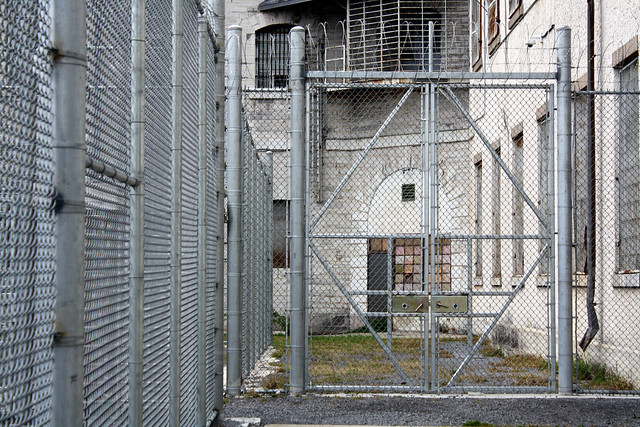

I look up at mangled razor wire atop the Gym building.
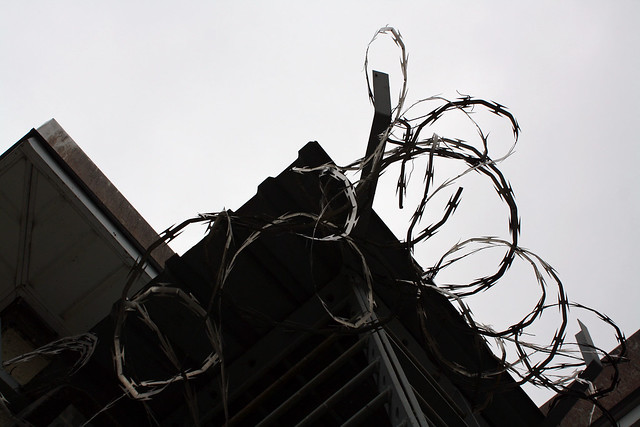
Around the corner the group stops under the Central West Guard Tower on the west wall, and I make a dash for the southwest corner of the prison. When the tour guide hollers at me that I've gone far enough, I stop and snap the shot of the Southwest Guard Tower, under which the open garage door reveals the splashing waves incoming on Lake Ontario.
Then I rejoin the group, again.

I turn the camera to the Central West Guard Tower and the west wall.


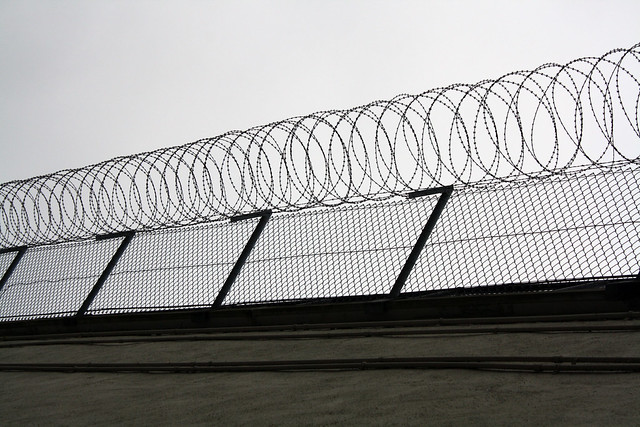
And right at this moment a free bird flies overhead.
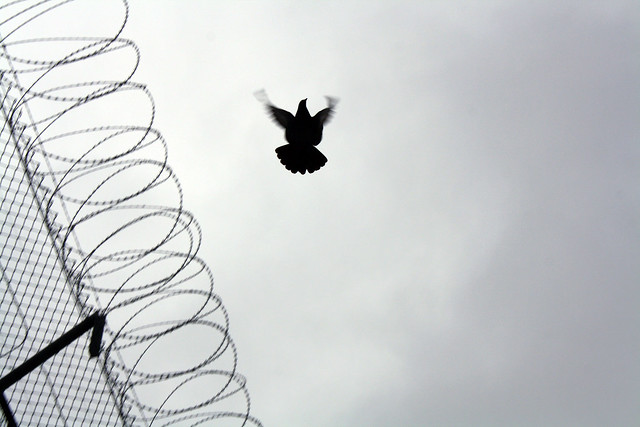
The Main Gate and Northwest Guard Tower.

The Administration Building (Former Women's Prison Building).
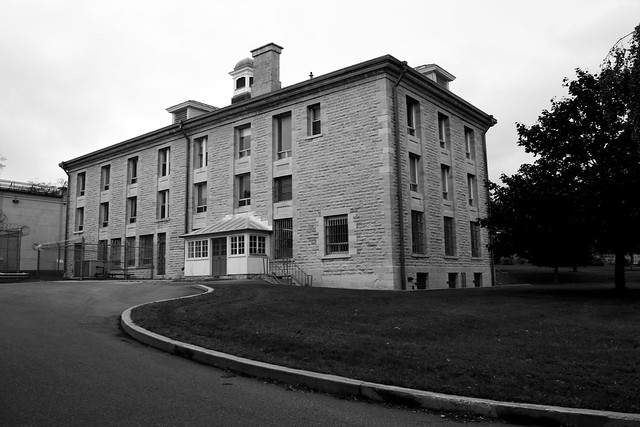
We linger behind the group one last time to capture the moment of us getting out of Kingston Penitentiary in the globe mirror on the wall under that Central West Guard Tower.
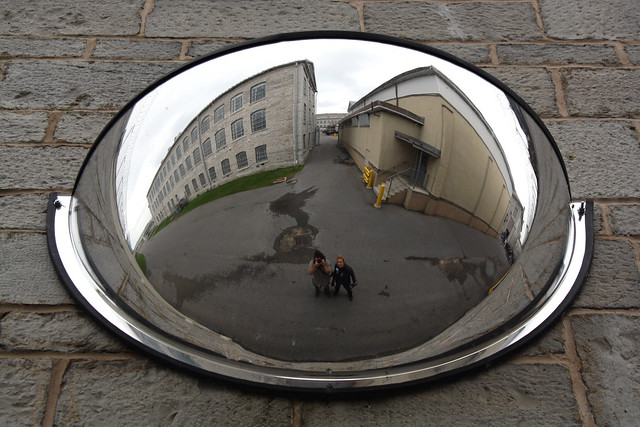

And despite my lack of good behaviour, we were released from Kingston Penitentiary.
Co-written by Jerm & Ninja IX.
***EDIT***Sunday, October 20, 2013***
Only a few days have passed, and here we are again, hoping to walk around the rear perimeter of the prison, which is of course not permitted.
We pass by the gate with a confident swagger and ignore the large sign warning that Civilian Entry is Strictly Prohibited. We round the corner under the Southeast Guard Tower and with no one in sight continue westward along the shoreline towards the rear gate.
The garage door, which was open during our tour a few days ago, is now closed. I saunter right up to it and start to lean in, raising my hand to my brow to block the sunlight, and just as I peek inside, it begins to open. The sound startles me.
We run around the corner. But I can't resist, and I turn around. The urge to see inside and capture just one more photograph from a different perspective, in this moment, is worth getting caught and suffering whatever consequences may arise.
I walk back around the corner and immediately come face to face with the guard manning the Rear Gate, walking towards me. I hop into character, playing the role of naive tourist number one. Announcing playfully that I'm just curious, I manage to snap a couple photographs before he even has a chance to react.
I expect to be grabbed onto forcefully and slapped silly by the hand of the law.
To my surprise, he responds pleasantly. He allows me to enter the garage door and photograph within the chain link fenced area of the Rear Gate. He then actually allows me inside to photograph the Rear Gate Control Booth.
Then the phone rings. The guard in the Main Control Booth is calling to assess the situation, as he has obviously watched us enter the Rear Gate on the many cameras that he is watching. The Rear Gate guard takes a minor ribbing for the security breach and hangs up the phone. He remains pleasant and friendly and we share with him our apologies and extreme gratitude for his generosity and kindness.

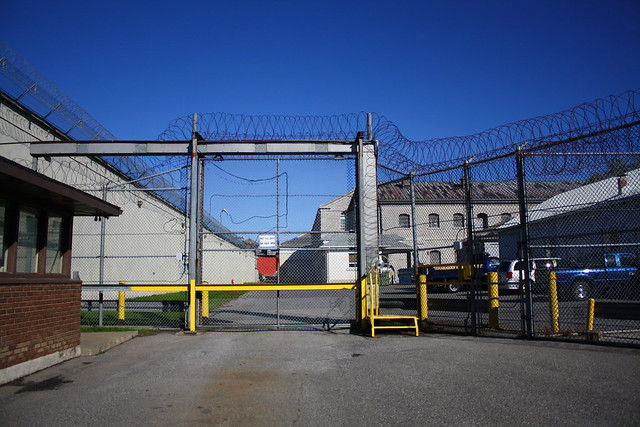
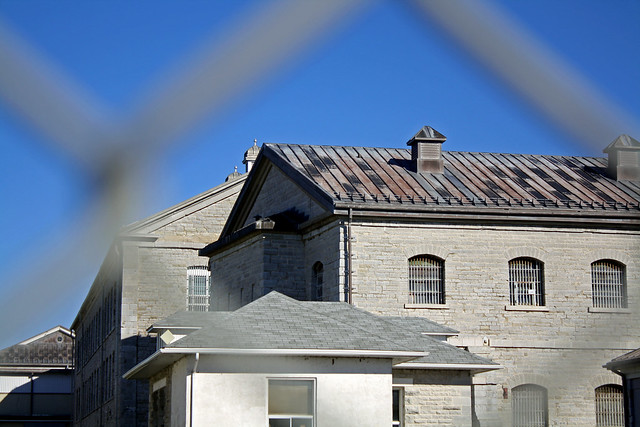
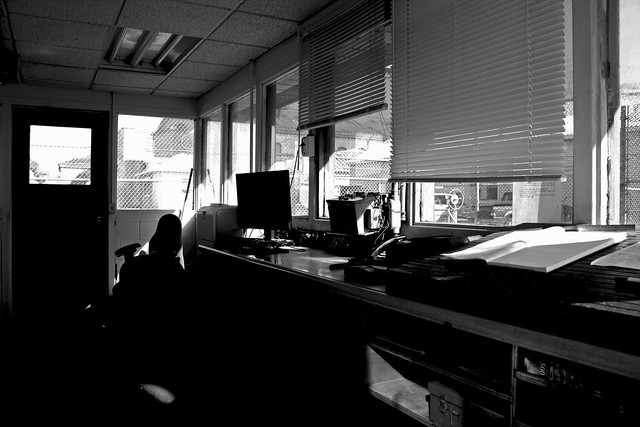

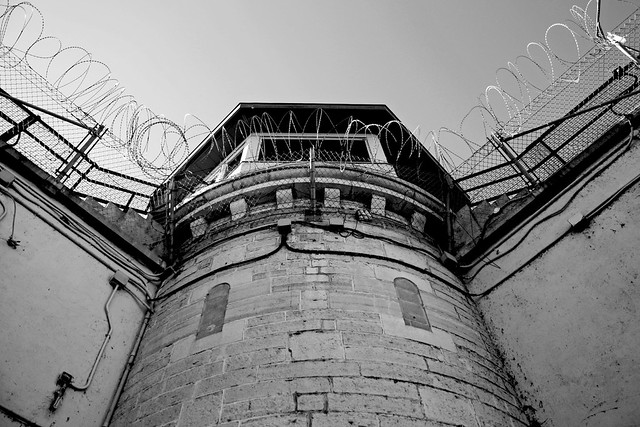
And yet again, we are set free.
click here to check out all of jerm & ninja IX's ABANDONMENT ISSUES

Around the corner the group stops under the Central West Guard Tower on the west wall, and I make a dash for the southwest corner of the prison. When the tour guide hollers at me that I've gone far enough, I stop and snap the shot of the Southwest Guard Tower, under which the open garage door reveals the splashing waves incoming on Lake Ontario.
Then I rejoin the group, again.

I turn the camera to the Central West Guard Tower and the west wall.



And right at this moment a free bird flies overhead.

The Main Gate and Northwest Guard Tower.

The Administration Building (Former Women's Prison Building).

We linger behind the group one last time to capture the moment of us getting out of Kingston Penitentiary in the globe mirror on the wall under that Central West Guard Tower.


And despite my lack of good behaviour, we were released from Kingston Penitentiary.
Co-written by Jerm & Ninja IX.
***EDIT***Sunday, October 20, 2013***
Only a few days have passed, and here we are again, hoping to walk around the rear perimeter of the prison, which is of course not permitted.
We pass by the gate with a confident swagger and ignore the large sign warning that Civilian Entry is Strictly Prohibited. We round the corner under the Southeast Guard Tower and with no one in sight continue westward along the shoreline towards the rear gate.
The garage door, which was open during our tour a few days ago, is now closed. I saunter right up to it and start to lean in, raising my hand to my brow to block the sunlight, and just as I peek inside, it begins to open. The sound startles me.
We run around the corner. But I can't resist, and I turn around. The urge to see inside and capture just one more photograph from a different perspective, in this moment, is worth getting caught and suffering whatever consequences may arise.
I walk back around the corner and immediately come face to face with the guard manning the Rear Gate, walking towards me. I hop into character, playing the role of naive tourist number one. Announcing playfully that I'm just curious, I manage to snap a couple photographs before he even has a chance to react.
I expect to be grabbed onto forcefully and slapped silly by the hand of the law.
To my surprise, he responds pleasantly. He allows me to enter the garage door and photograph within the chain link fenced area of the Rear Gate. He then actually allows me inside to photograph the Rear Gate Control Booth.
Then the phone rings. The guard in the Main Control Booth is calling to assess the situation, as he has obviously watched us enter the Rear Gate on the many cameras that he is watching. The Rear Gate guard takes a minor ribbing for the security breach and hangs up the phone. He remains pleasant and friendly and we share with him our apologies and extreme gratitude for his generosity and kindness.






And yet again, we are set free.
click here to check out all of jerm & ninja IX's ABANDONMENT ISSUES



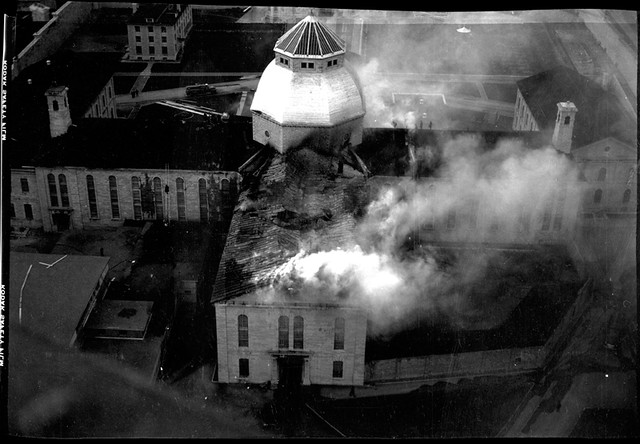
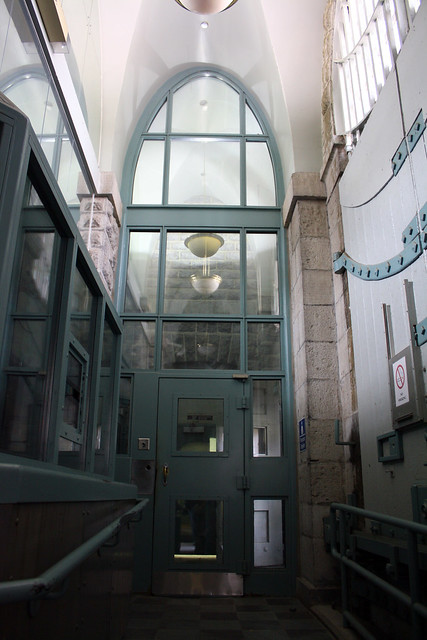
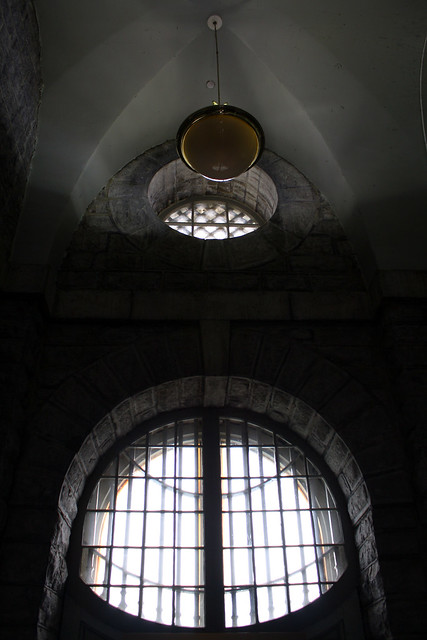
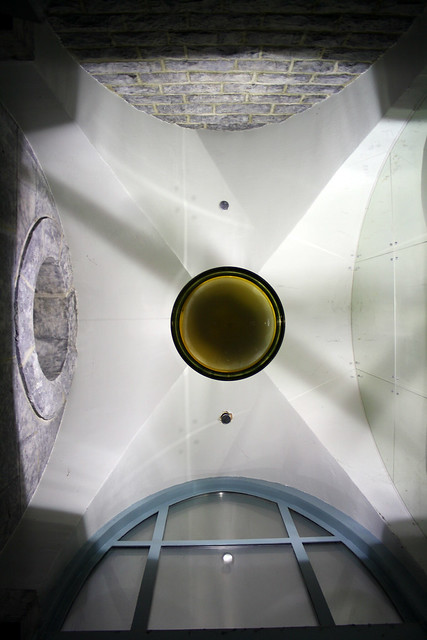
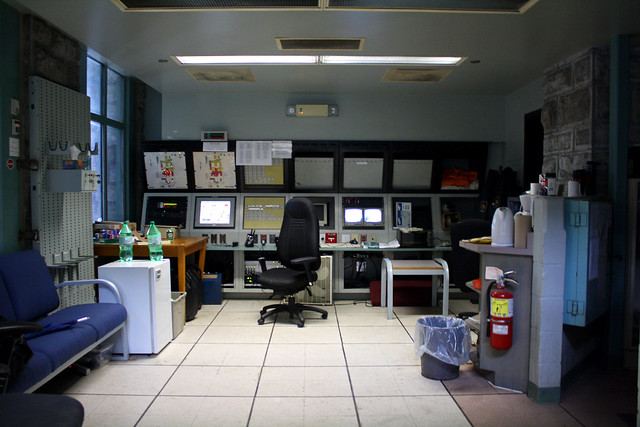
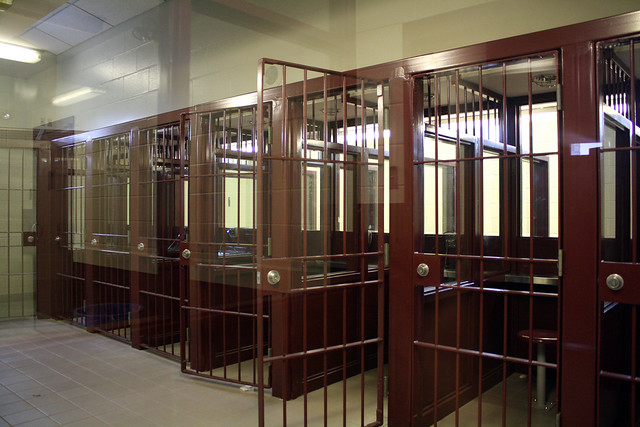
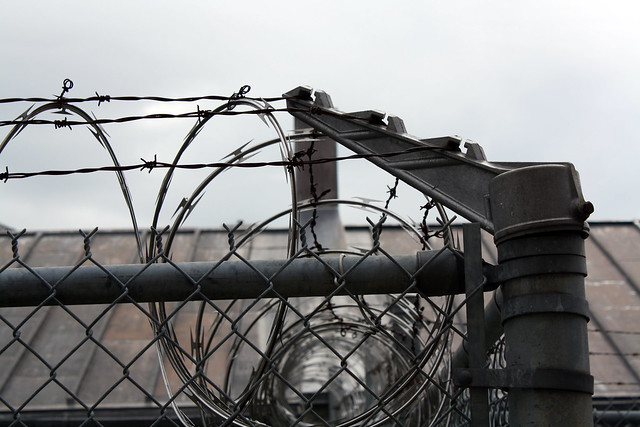
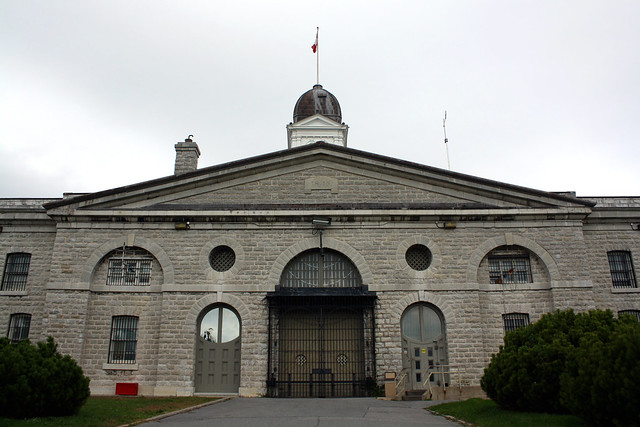
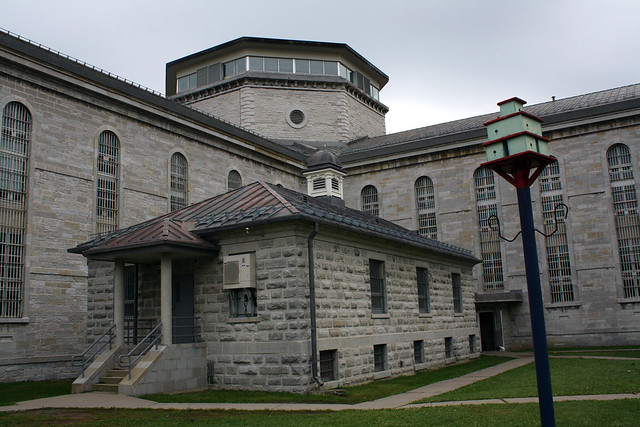

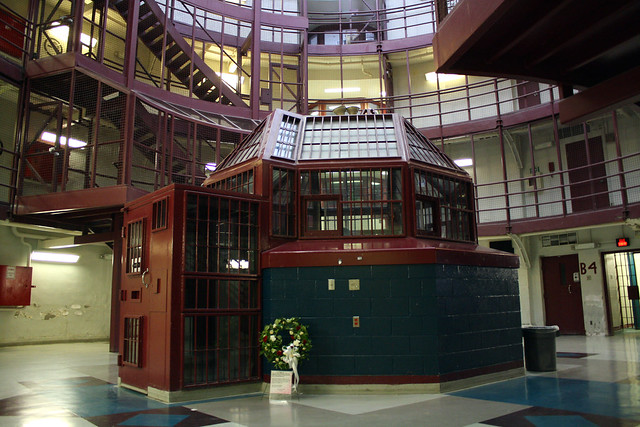

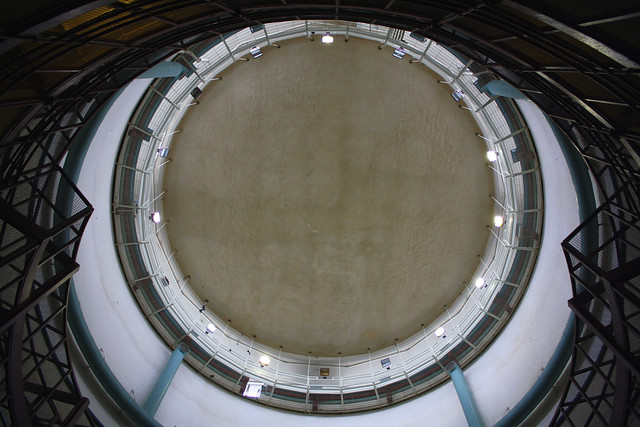
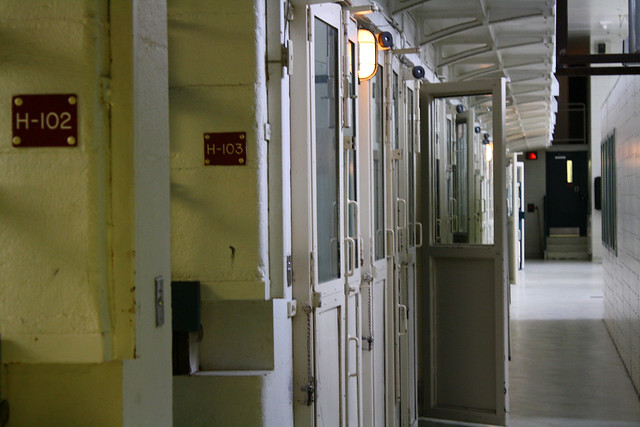






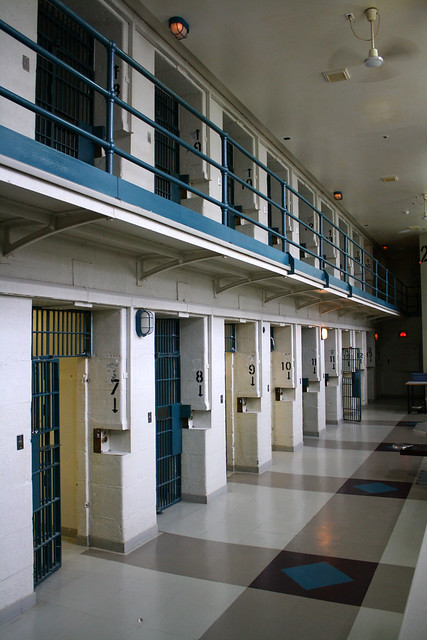
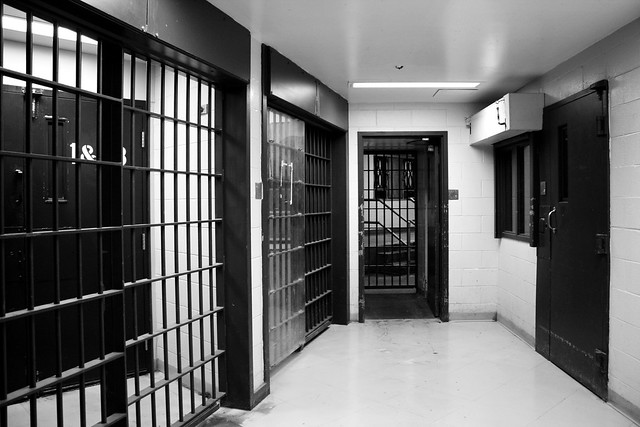
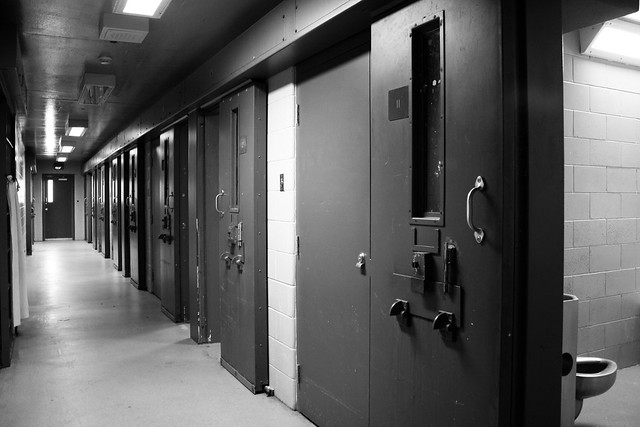
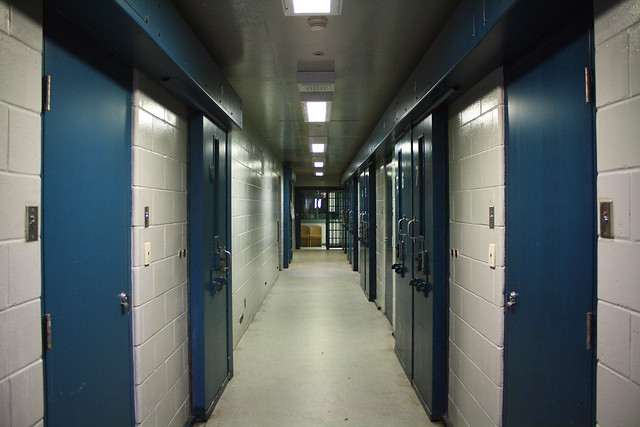

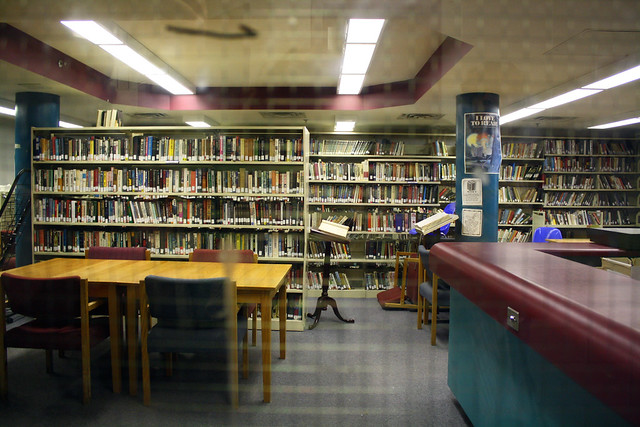
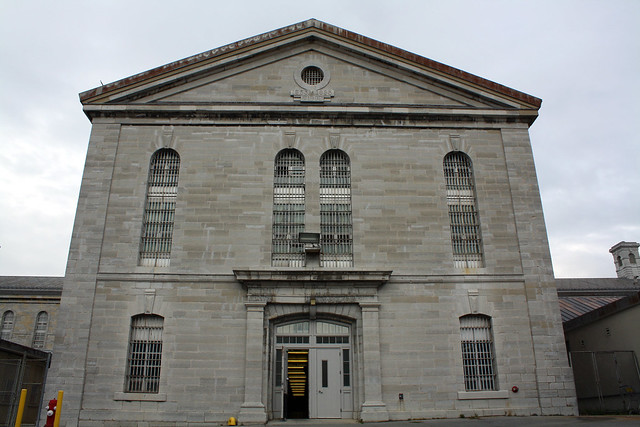


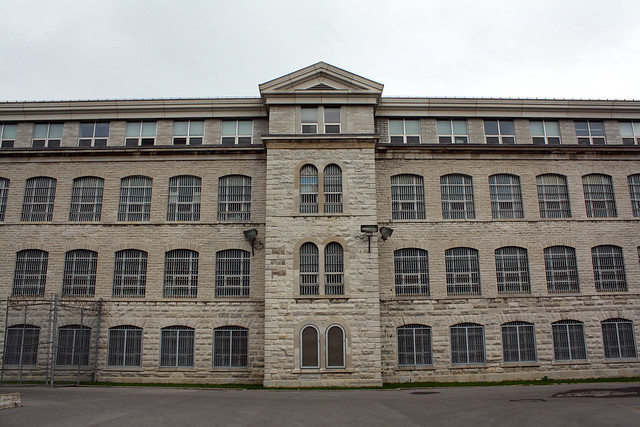
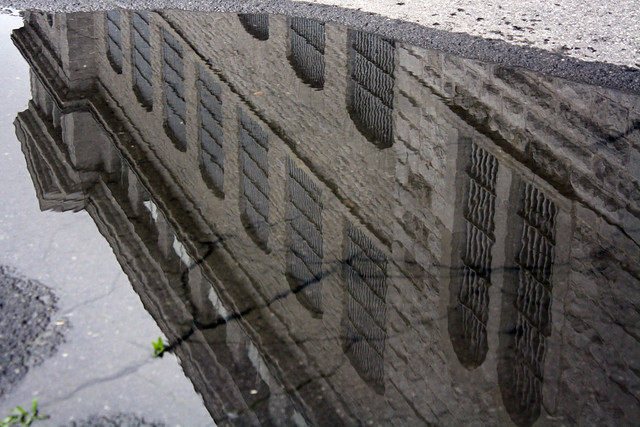

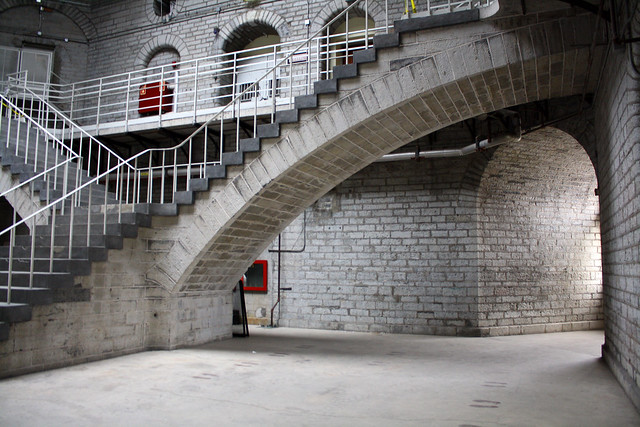
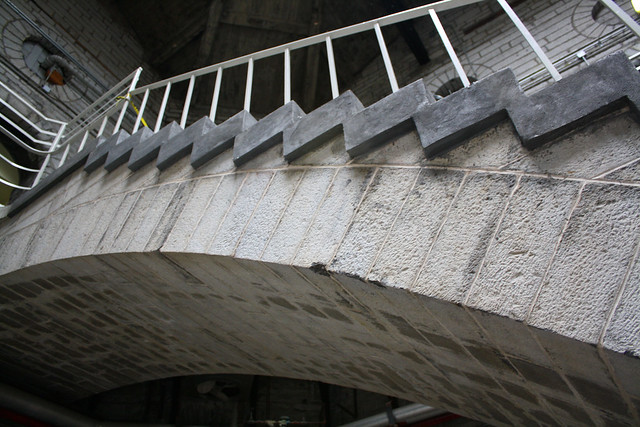
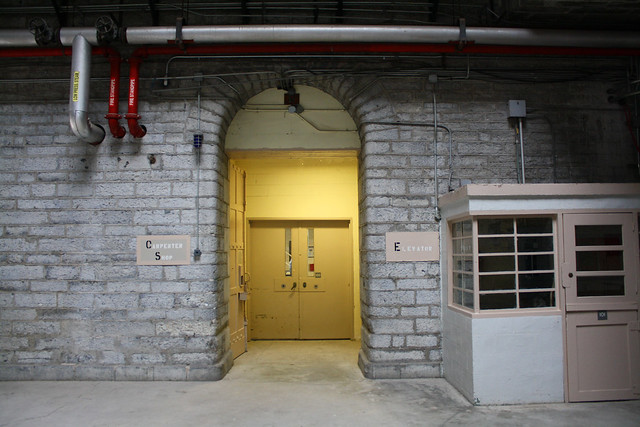
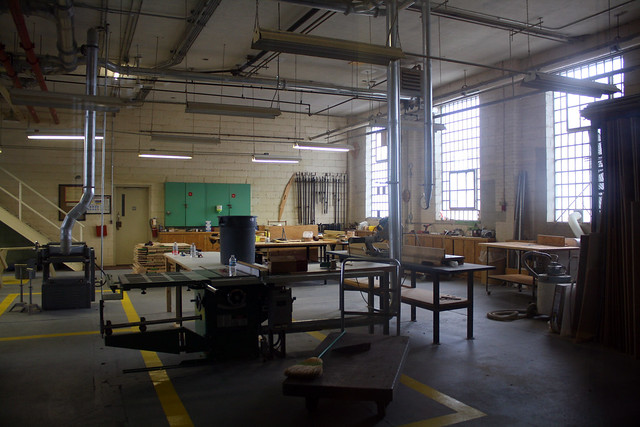
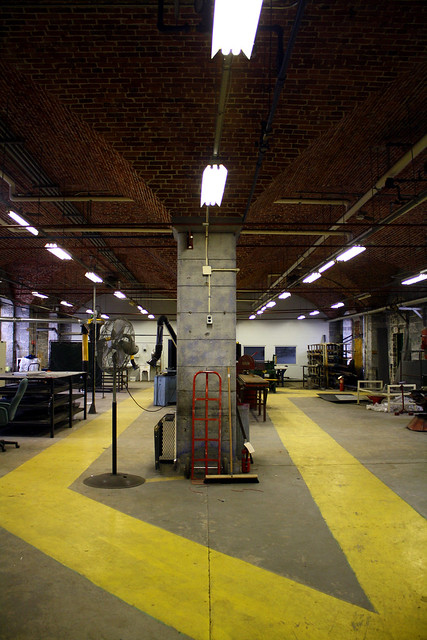
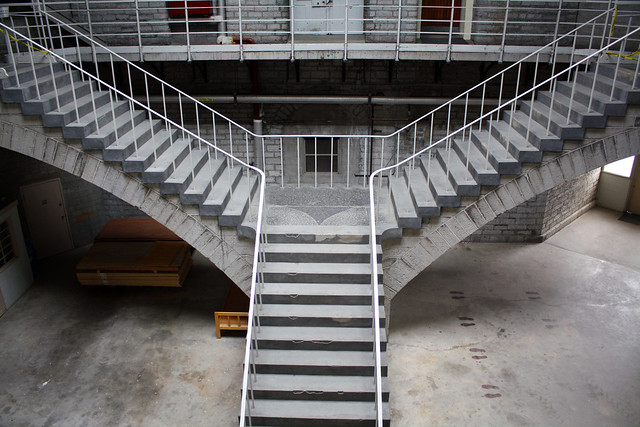
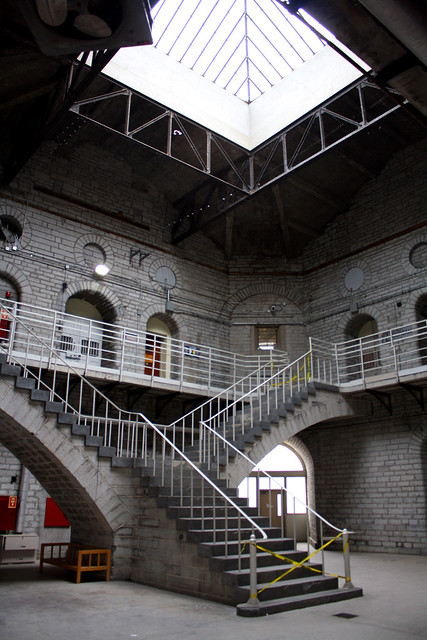


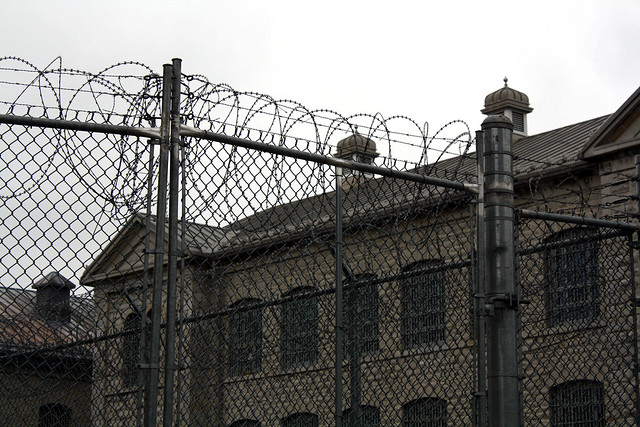
16 comments:
fantastic as always....
Vic Toews is wrong about KP. How could a prisoner be rehabilitated and reintegrated into society when he is locked up behind a solid door cell? At least at KP the doors were bared (except Segregation). They could have easily put all the money and effort it took to close the place into retrofitting the building and bring it up to "21st century standards". For those who have toured the facility will realize that it is still a solid building and will stand another 200 years. Some of the other prisons built in the mid nineties are in a far worse shape than KP.
The government has made a big mistake in shutting the place down. Vic Toews you have accomplished what he swore you would do as though it was something personal.Funny he shut down two prisons that the guards refused work a certain post-Kingston Penitentiary and the Leclerc Institution. The latter built after Joyceville Penitentiary. Anyway something to think about people.
I have been reading your Blog for probably about a year and love it! Your writing style and stories draw the reader in.
I shared this article on facebook and was messaged the next day by my uncle. This particular article has a connection to my family that I had never known. It seems my GR GR GR GR Grandfather William Abraham was sent there for murdering his son while drunk in july of 1856 then died there in 1859. Had I not shared this blog I may have never heard that piece of family history.
So thanks to Jerm IX for the reading and my uncle for the family history lesson.
Keep up the great work you do with this blog Jeremiah!
Re: :How could a prisoner be rehabilitated and reintegrated into society when he is locked up behind a solid door cell?: writes Kevin Tapp . so how would they pay for their crimes if not incarcerated? I would support a motion to hang them all but I am certain you would not like that at all.
I came across you blog from Flickr. I did the KP Tour also. I still have the chills. The research you have done and your write-ups are captivating. Along with both yours and Ninja's awesome photos, I could spend hours here.
Just fantastic!
Those were Commissionaires you were talking to at the SouthWest Sally Port, not Correctional Officers..... you must have shown up on a weekend or evening...
And yes, you're lucky to have gotten those pictures, as technically you were trespassing on the federal reserve.....
I'm wondering if you have an e-mail address, as you have several technical errors in the man body of your post, that need correction, and it's better done via e-mail.
Absolutely fantastic.. probably better then the actual physical tour.
Thank you
Thank you all for the comments. Anonymous, hit me up at jerm9ine@gmail.com
Hi, hopefully they will one day allow people to physically tour the Kingston Pen. Was in Kingston a few years ago and made a point of visiting the Kingston Pen museum and walking over to the front of the jail. I find it fascinating.
Great pictures but there are more areas that deserve recognition too. Having worked at KP both as a school teacher and Parole Officer this institution must be preserved as an vital part of Kingston's and Canada's history, will the federal government recognize this? Just an aside I also lived right next door to KP for over 30 years and other than 1971 they were very quiet neighbours, never dropped in for coffee nor had to keep up with the "Jones"!
Re "oldest prison in the world": it is not KP. I've been to the Fortezza Medicea in Volterra Italy, which might hold the dubious record. Built in 1474 as a fortress/prison by the Medici family, it still operates as a high security prison and, miraculously, a popular restaurant.
Victor G. Clarke, Kingston
The rationale for the closure of this institution will be clouded by political mystery and a lack of insight into the daily operations and management of the most unmanageable inmate population from across canada.
The pictures show a very unimaginable living environment for most of us, but remember the phrase " managing risk". These risks will now occupy the segregation units across the country. As foreign as the environment seems I assure you the lifestyles and challenges it's inhabitants undertook to be placed there far exceed anything you might imagine. This does not exclude them from humanity, this simply limits their ability to succum to the triggers, violence, and illness that has governed their lives, while protecting society.
Officers and support staff are often claimed by the environment, where many could lose sight of the human component but all proceed daily to exercise, safe secure and humane control attempting to affect a positive change in an inmates life. Some offer greater challenges and some significantly less.
The building was tactically best suited to immediate response to incidents, is in significantly better condition than other local institutions, was staffed by well suited adaptive, intuitive staff that interacted daily with every inmate in a positive authoritive and humane manner.
Politically driven decisions in this case failed the correctional service of canada, and the people of canada. Sometimes costs have immeasurable benefits. CX 12 years
I found this very interesting and wish I could take the tour. I had an Uncle, by marriage, spend some time in KP and had lost privileges for talking. He worked as a baker during his time there. I found out that he had spent time in KP while doing my family tree. I wanted to know more about my relatives time there and why he was sent there, I contacted the Penitentiary Museum and the gentleman there was very helpful and sent me copies of my Uncle's records and a newspaper article about his arrest. I was the first person to ask him to help research the information, he enjoyed doing the research as much as I enjoyed receiving it.
Very good and informative read.
First off I love the work you do on this site and hope you keep it up. I just did the new version of the tour today and sad to say the entire prison was stripped of everything. Two cells were set up on the one range we could on on but other than that everything from cameras to tables are gone.All the shops were filled with stacks of racking and various crap they plan to install.The main yard you show is now gone to set up for some police equestrian competition. Sad to see they are not keeping this in original form for future generations to see. Glad I got to see your tour to see the real experience.
Nice job.
Post a Comment